Patterns of Nighttime Crowd Flows in Tourism Cities Based on Taxi Data—Take Haikou Prefecture as an Example
Abstract
:1. Introduction
2. Data
2.1. Land Use Data for Haikou
2.2. LJ1-01 Nighttime Light Data
2.3. Taxi Data
- As a typical representative of a tourism city, Haikou has a large proportion of the mobile population (or called “tourists”) and a low rate of private car ownership compared with conventional cities, especially in the peak tourism season selected for this paper. For the group of tourists studied in this research, car-hailing services become a valuable tool at night, facilitating their travel while extending the time of economic activity;
- Didi accounted for over 90% of all car-hailing services in China at the time of the statistics. Simultaneously, all cruising taxis in Haikou have been connected to and integrated with the Didi platform since 2017. Therefore, the taxi order data counted by Didi include dominated car-hailing taxis and traditional taxi data;
- According to information found from Haikou Government, most bus and shuttle services operate from 6 a.m. to 10 p.m. Additionally, due to known safety hazards, the number of people walking late at night is very rare and difficult to count, and the use of shared transportation at night is significantly reduced [36]. In summary, from 9 p.m. to 5 am, the evening peak hour has ended, and public transportation services have also almost been suspended; thus, taxi orders are the most accurate reflection of human night mobility characteristics.
3. Methods
3.1. Geogrid-Based Analysis
3.2. Spatial-Temporal Dimensionality Reduction and Clustering of Crowd Flows
3.2.1. DCNMF Dimensionality Reduction
| Algorithm 1. Dual Semi-Supervised Convex NMF (DCNMF) algorithm. |
| Input: Data matrix , label constraint matrix , parameter K = 4. |
| Output: a base matrix and a coefficient matrix . |
| 1: Initialize matrices W and Z; |
| 2: Construct the weight matrix v by using CPA; |
| 3: Update by using (9); |
| 4: Update by using (10); |
| 5: If not Convergence, return step (3); |
| 6: , . |
3.2.2. Clustering of Crowd Flows’ Changes Based on Geogrids
| Algorithm 2. Dual Semi-Supervised Convex NMF (DCNMF) algorithm. |
| Input: coefficient matrix , label constraint matrix , cluster types = 4. |
| Output: geogrid cluster type matrix (“pick-up”, “drop-off” and “in-out” table). |
| 1: Select samples of different types in as the initial clustering center,; |
| 2: For each sample ith column in , calculate the distance from sample to the cluster centers; |
| 3: divide each sample into the class corresponding to the cluster center with the smallest distance; |
| 4: For each cluster type, recalculate its cluster center ; |
| 5: If not Convergence, return step (2); |
| 6: If not complete three tables, return step (1); |
| 7: Output geogrid nighttime crowd flows’ changes cluster type matrix in three flow tables. |
3.2.3. Methodological Evaluation
4. Results
4.1. Statistical Analysis of Taxi Flows with Land Use Geogrid
4.2. Changes in Nighttime Patterns of Crowd Flows Aimed at Different Time Periods
4.3. A Comparison of Citywide and Downtown Crowd Flows
4.4. Influence of the Nighttime Light Intensity on the Pattern of Crowd Flows
5. Discussion
6. Conclusions
- By incorporating land use data, the crowd flows obtained by taxi services are no longer limited to point-to-point analysis, which provides a baseline for future grid-based analysis in smart cities;
- Due to the high resolution of LJ1-01 in east Asia, the association with the LJ1-01 nighttime light image makes the update of night population density information more accurate. The traditional machine learning and deep learning methods are difficult to effectively extract spatio-temporal information because of multi-source and heterogeneous data. In this paper, the semi-supervised DCNMF and K-Means method is used to successfully complete the spatio-temporal dimension reduction and clustering. Then, the three types of data ((taxi orders, LJ1-01 nighttime light data and land use data)) are organically combined to explain the patterns of nighttime crowd flows from different angles.
- We also analyze the crowd flows’ pattern changes in Haikou “before midnight” and “after midnight” and between downtown and citywide areas. It was found that the greater the lag in crowd flow in a certain area is (that is, the clustering of crowd flow change is “increase then decrease” or especially “decrease then increase”), the more prosperous and higher population density the area is, and the greater the land use patterns are closer to downtown residential and commercial areas. Thus, the prosperity of land use areas shows a high positive correlation with the lag of crowd flows. For every 5% increase in population density, the peak of crowd flows will be delayed by 30 min.
Author Contributions
Funding
Institutional Review Board Statement
Informed Consent Statement
Data Availability Statement
Acknowledgments
Conflicts of Interest
References
- Ali, A.; Zhu, Y.; Chen, Q.; Yu, J.; Cai, H. Leveraging Spatio-Temporal Patterns for Predicting Citywide Traffic Crowd Flows Using Deep Hybrid Neural Networks. In Proceedings of the 2019 IEEE 25th International Conference on Parallel and Distributed Systems (ICPADS), Tianjin, China, 4–6 December 2019. [Google Scholar]
- Tao, R.; Thill, J.-C. BiFlowLISA: Measuring spatial association for bivariate flow data. Comput. Environ. Urban Syst. 2020, 83, 101519. [Google Scholar] [CrossRef]
- Ebrahimpour, Z.; Wan, W.; Cervantes, O.; Luo, T.; Ullah, H. Comparison of Main Approaches for Extracting Behavior Features from Crowd Flow Analysis. ISPRS Int. J. Geo-Inf. 2019, 8, 440. [Google Scholar] [CrossRef] [Green Version]
- Fan, Z.; Pei, T.; Ma, T.; Du, Y.; Song, C.; Liu, Z.; Zhou, C. Estimation of urban crowd flux based on mobile phone location data: A case study of Beijing, China. Comput. Environ. Urban Syst. 2018, 69, 114–123. [Google Scholar] [CrossRef]
- Alessandretti, L.; Aslak, U.; Lehmann, S. The scales of human mobility. Nature 2020, 587, 402–407. [Google Scholar] [CrossRef] [PubMed]
- Yang, Y.; Heppenstall, A.; Turner, A.; Comber, A. A spatiotemporal and graph-based analysis of dockless bike sharing patterns to understand urban flows over the last mile. Comput. Environ. Urban Syst. 2019, 77, 101361. [Google Scholar] [CrossRef]
- Tang, J.; Liu, F.; Wang, Y.; Wang, H. Uncovering urban human mobility from large scale taxi GPS data. Phys. A Stat. Mech. Its Appl. 2015, 438, 140–153. [Google Scholar] [CrossRef]
- Barbosa, H.; Barthelemy, M.; Ghoshal, G.; James, C.R.; Lenormand, M.; Louail, T.; Tomasini, M. Human mobility: Models and applications. Phys. Rep. 2018, 734, 1–74. [Google Scholar] [CrossRef] [Green Version]
- Yao, C.-Z.; Lin, J.-N. A study of human mobility behavior dynamics: A perspective of a single vehicle with taxi. Transp. Res. Part A Policy Pract. 2016, 87, 51–58. [Google Scholar] [CrossRef]
- Ren, Y.; Chen, H.; Han, Y.; Cheng, T.; Zhang, Y.; Chen, G. A hybrid integrated deep learning model for the prediction of citywide spatio-temporal flow volumes. Int. J. Geogr. Inf. Sci. 2020, 34, 802–823. [Google Scholar] [CrossRef]
- Huang, Z.; Ling, X.; Wang, P.; Zhang, F.; Mao, Y.; Lin, T.; Wang, F.-Y. Modeling real-time human mobility based on mobile phone and transportation data fusion. Transp. Res. Part C Emerg. Technol. 2018, 96, 251–269. [Google Scholar] [CrossRef]
- Wang, A.; Zhang, A.; Chan, E.H.W.; Shi, W.; Zhou, X.; Liu, Z. A Review of Human Mobility Research Based on Big Data and Its Implication for Smart City Development. ISPRS Int. J. Geo-Inf. 2020, 10, 13. [Google Scholar] [CrossRef]
- Jiang, Y.; Huang, X.; Li, Z. Spatiotemporal Patterns of Human Mobility and Its Association with Land Use Types during COVID-19 in New York City. ISPRS Int. J. Geo-Inf. 2021, 10, 344. [Google Scholar] [CrossRef]
- Chen, F.; Yin, Z.; Ye, Y.; Sun, D. Taxi hailing choice behavior and economic benefit analysis of emission reduction based on multi-mode travel big data. Transp. Policy 2020, 97, 73–84. [Google Scholar] [CrossRef]
- Sun, D.; Ding, X. Spatiotemporal evolution of ridesourcing markets under the new restriction policy: A case study in Shanghai. Transp. Res. Part A Policy Pract. 2019, 130, 227–239. [Google Scholar] [CrossRef]
- Sabouri, S.; Brewer, S.; Ewing, R. Exploring the relationship between ride-sourcing services and vehicle ownership, using both inferential and machine learning approaches. Landsc. Urban Plan. 2020, 198, 103797. [Google Scholar] [CrossRef]
- Kong, X.; Xia, F.; Wang, J.; Rahim, A.; Das, S.K. Time-location-relationship combined service recommendation based on taxi trajectory data. IEEE Trans. Ind. Inform. 2017, 13, 1202–1212. [Google Scholar] [CrossRef]
- Li, Q.; Zeng, Z.; Zhang, T.; Li, J.; Wu, Z. Path-finding through flexible hierarchical road networks: An experiential approach using taxi trajectory data. Int. J. Appl. Earth Obs. Geoinf. 2011, 13, 110–119. [Google Scholar] [CrossRef]
- Cartlidge, J.; Gong, S.; Bai, R.; Yue, Y.; Qiu, G. Spatio-temporal Prediction of Shopping Behaviours Using Taxi Trajectory Data. In Proceedings of the 2018 IEEE 3rd International Conference on Big Data Analysis (ICBDA), Shanghai, China, 9–12 March 2017. [Google Scholar]
- Xiong, H.; Xie, K.; Ma, L.; Yuan, F.; Shen, R.; Vanajakshi, L. Exploring the Citywide Human Mobility Patterns of Taxi Trips through a Topic-Modeling Analysis. J. Adv. Transp. 2021, 2021, 6697827. [Google Scholar] [CrossRef]
- Luo, X.; Yuan, Y.; Li, Z.; Zhu, M.; Xu, Y.; Chang, L.; Ding, Z. FBVA: A Flow-Based Visual Analytics Approach for Citywide Crowd Mobility. IEEE Trans. Comput. Soc. Syst. 2019, 6, 277–288. [Google Scholar] [CrossRef]
- Zhou, Q.; Gu, J.-J.; Ling, C.; Li, W.-B.; Zhuang, Y.; Wang, J. Exploiting Multiple Correlations Among Urban Regions for Crowd Flow Prediction. J. Comput. Sci. Technol. 2020, 35, 338–352. [Google Scholar] [CrossRef]
- Siła-Nowicka, K.; Vandrol, J.; Oshan, T.; Long, J.A.; Demšar, U.; Fotheringham, A.S. Analysis of human mobility patterns from GPS trajectories and contextual information. Int. J. Geogr. Inf. Sci. 2016, 30, 881–906. [Google Scholar] [CrossRef] [Green Version]
- Chang, Y.; Wang, S.; Zhou, Y.; Wang, L.; Wang, F. A Novel Method of Evaluating Highway Traffic Prosperity Based on Nighttime Light Remote Sensing. Remote Sens. 2019, 12, 102. [Google Scholar] [CrossRef] [Green Version]
- Chen, Z.; Wei, Y.; Shi, K.; Zhao, Z.; Wang, C.; Wu, B.; Yu, B. The potential of nighttime light remote sensing data to evaluate the development of digital economy: A case study of China at the city level. Comput. Environ. Urban Syst. 2022, 92, 101749. [Google Scholar] [CrossRef]
- Liu, L.; Zhou, H.; Lan, M.; Wang, Z. Linking Luojia 1-01 nightlight imagery to urban crime. Appl. Geogr. 2020, 125, 102267. [Google Scholar] [CrossRef]
- Dickinson, B.; Ghoshal, G.; Dotiwalla, X.; Sadilek, A.; Kautz, H. Inferring Nighttime Satellite Imagery from Human Mobility. In Proceedings of the AAAI Conference on Artificial Intelligence, New York, NY, USA, 7–12 February 2020; Volume 34, pp. 394–402. [Google Scholar] [CrossRef]
- Peng, S.; Yang, Z.; Ling, B.W.-K.; Chen, B.; Lin, Z. Dual semi-supervised convex nonnegative matrix factorization for data representation. Inf. Sci. 2022, 585, 571–593. [Google Scholar] [CrossRef]
- Yuan, J.; Zheng, Y.; Xie, X. Discovering regions of different functions in a city using human mobility and POIs. In Proceedings of the 18th ACM SIGKDD International Conference on Knowledge Discovery and Data Mining, Beijing, China, 12–16 August 2012. [Google Scholar]
- Chen, X.; Nordhaus, W.D. Using luminosity data as a proxy for economic statistics. Proc. Natl. Acad. Sci. USA 2011, 108, 8589–8594. [Google Scholar] [CrossRef] [Green Version]
- Shang, Y.; Zheng, X.; Han, R.; Liu, W.; Xiao, F. Long-term evaluation on urban intensive land use in five fast-growing cities of northern China with GEE support. Sci. Rep. 2021, 11, 20734. [Google Scholar] [CrossRef]
- Li, R.; Dong, L.; Zhang, J.; Wang, X.; Wang, W.X.; Di, Z.; Stanley, H.E. Simple spatial scaling rules behind complex cities. Nat. Commun. 2017, 8, 1841. [Google Scholar] [CrossRef] [Green Version]
- Lu, D.; Wang, Y.; Yang, Q.; Su, K.; Zhang, H.; Li, Y. Modeling Spatiotemporal Population Changes by Integrating DMSP-OLS and NPP-VIIRS Nighttime Light Data in Chongqing, China. Remote Sens. 2021, 13, 284. [Google Scholar] [CrossRef]
- Li, X.; Li, X.; Li, D.; He, X.; Jendryke, M. A preliminary investigation of Luojia-1 night-time light imagery. Remote Sens. Lett. 2019, 10, 526–535. [Google Scholar] [CrossRef]
- Wang, H.; Xiao, G.-Y.; Zhang, L.-Y.; Ji, Y. Transportation Network Design considering Morning and Evening Peak-Hour Demands. Math. Probl. Eng. 2014, 2014, 806916. [Google Scholar] [CrossRef] [Green Version]
- Wu, X.; Xiao, W.; Deng, C.; Schwebel, D.C.; Hu, G. Unsafe riding behaviors of shared-bicycle riders in urban China: A retrospective survey. Accid. Anal. Prev. 2019, 131, 1–7. [Google Scholar] [CrossRef] [PubMed]
- Zhang, J.; Zheng, Y.; Qi, D. Deep spatio-temporal residual networks for citywide crowd flows prediction. In Proceedings of the Thirty-First AAAI Conference on Artificial Intelligence, San Francisco, CA, USA, 4–9 February 2017. [Google Scholar]
- Kim, J.; Park, H. Sparse Nonnegative Matrix Factorization for Clustering; Georgia Institute of Technology: Atlanta, GA, USA, 2008. [Google Scholar]
- Esposito, F.; Boccarelli, A.; del Buono, N. An NMF-Based Methodology for Selecting Biomarkers in the Landscape of Genes of Heterogeneous Cancer-Associated Fibroblast Populations. Bioinform. Biol. Insights 2020, 14, 1177932220906827. [Google Scholar] [CrossRef]
- Cai, H.; Liu, B.; Xiao, Y.; Lin, L. Semi-Supervised Multi-view clustering based on orthonormality-constrained nonnegative matrix factorization. Inf. Sci. 2020, 536, 171–184. [Google Scholar] [CrossRef]
- Naw, N.; Theingi, P. Crowd Group Detection by Using Collective Transition Prior with K-Means Clustering. 2020, 1, 101–104. Available online: https://www.researchgate.net/publication/342392497_Crowd_Group_Detection_by_Using_Collective_Transition_Prior_with_K-Means_Clustering (accessed on 7 February 2022).
- Hu, F.; Li, Z.; Yang, C.; Jiang, Y. A graph-based approach to detecting tourist movement patterns using social media data. Cartogr. Geogr. Inf. Sci. 2019, 46, 368–382. [Google Scholar] [CrossRef]
- Chen, J.; Yang, S.; Li, H.; Zhang, B.; Lv, J. Research on geographical environment unit division based on the method of natural breaks (Jenks). Int. Arch. Photogramm. Remote Sens. Spat. Inf. Sci. 2013, 3, 47–50. [Google Scholar] [CrossRef] [Green Version]
- Zhang, W.; Qi, G.; Pan, G.; Lu, H.; Li, S.; Wu, Z. City-scale social event detection and evaluation with taxi traces. ACM Trans. Intell. Syst. Technol. 2015, 6, 1–20. [Google Scholar] [CrossRef] [Green Version]
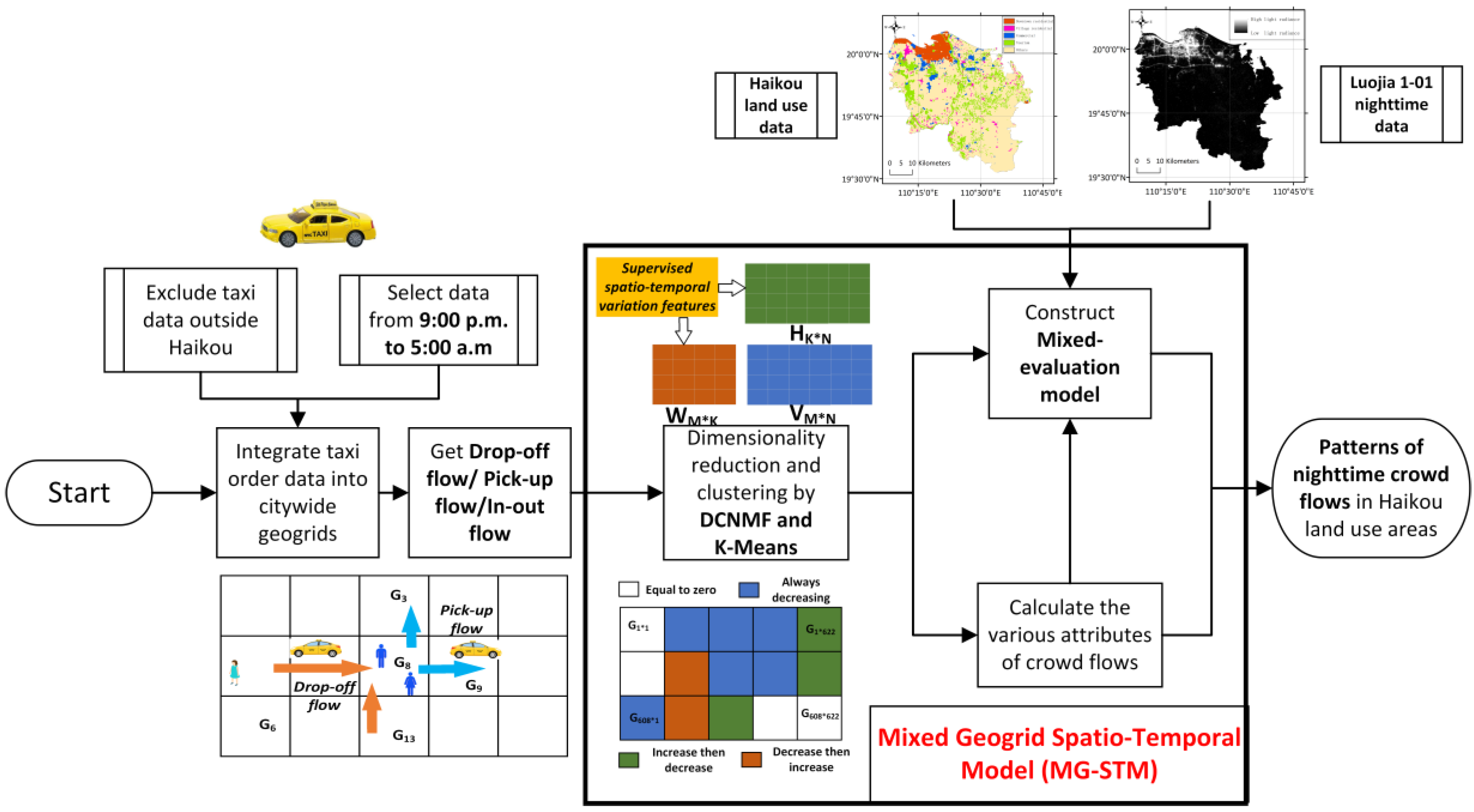
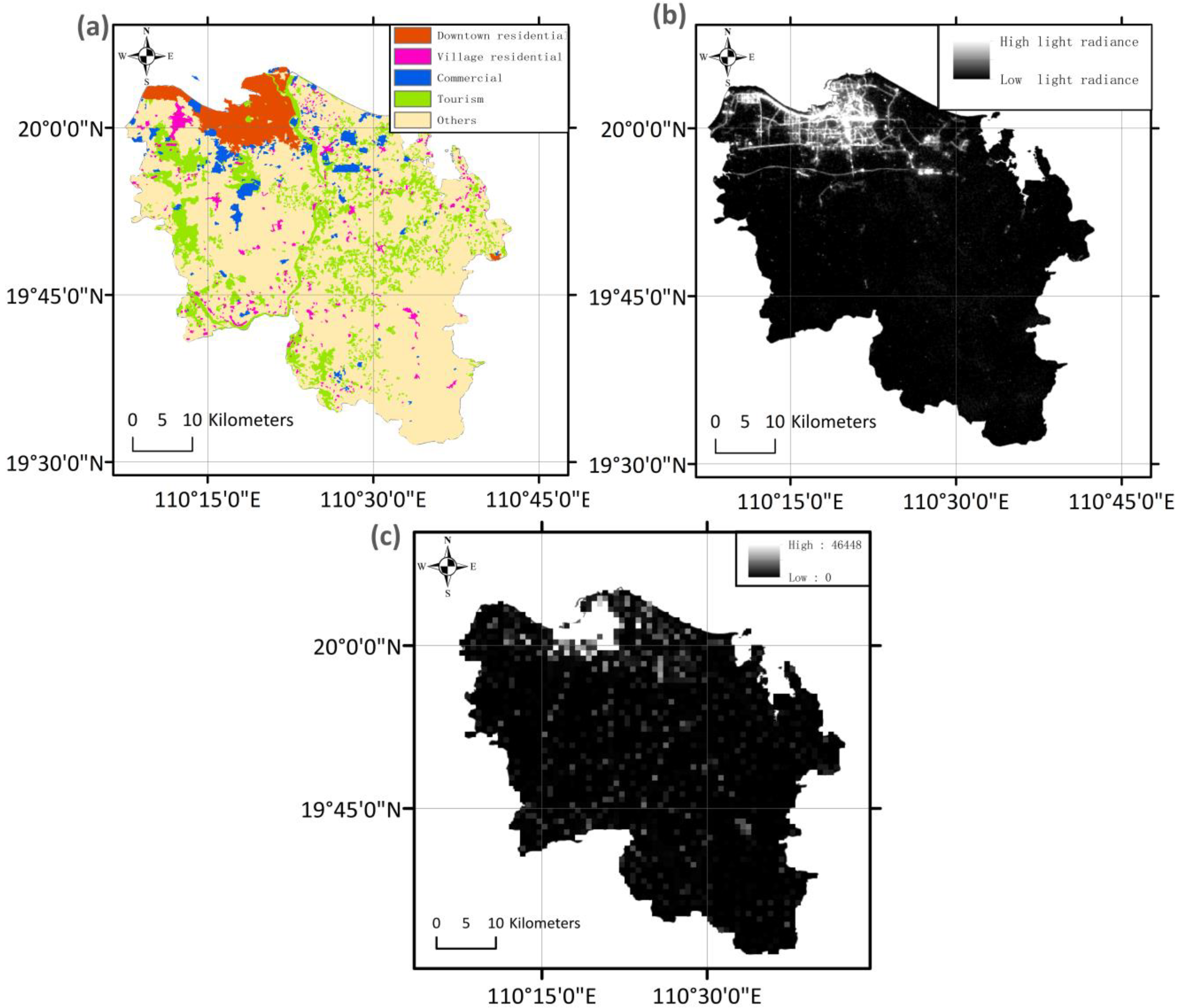
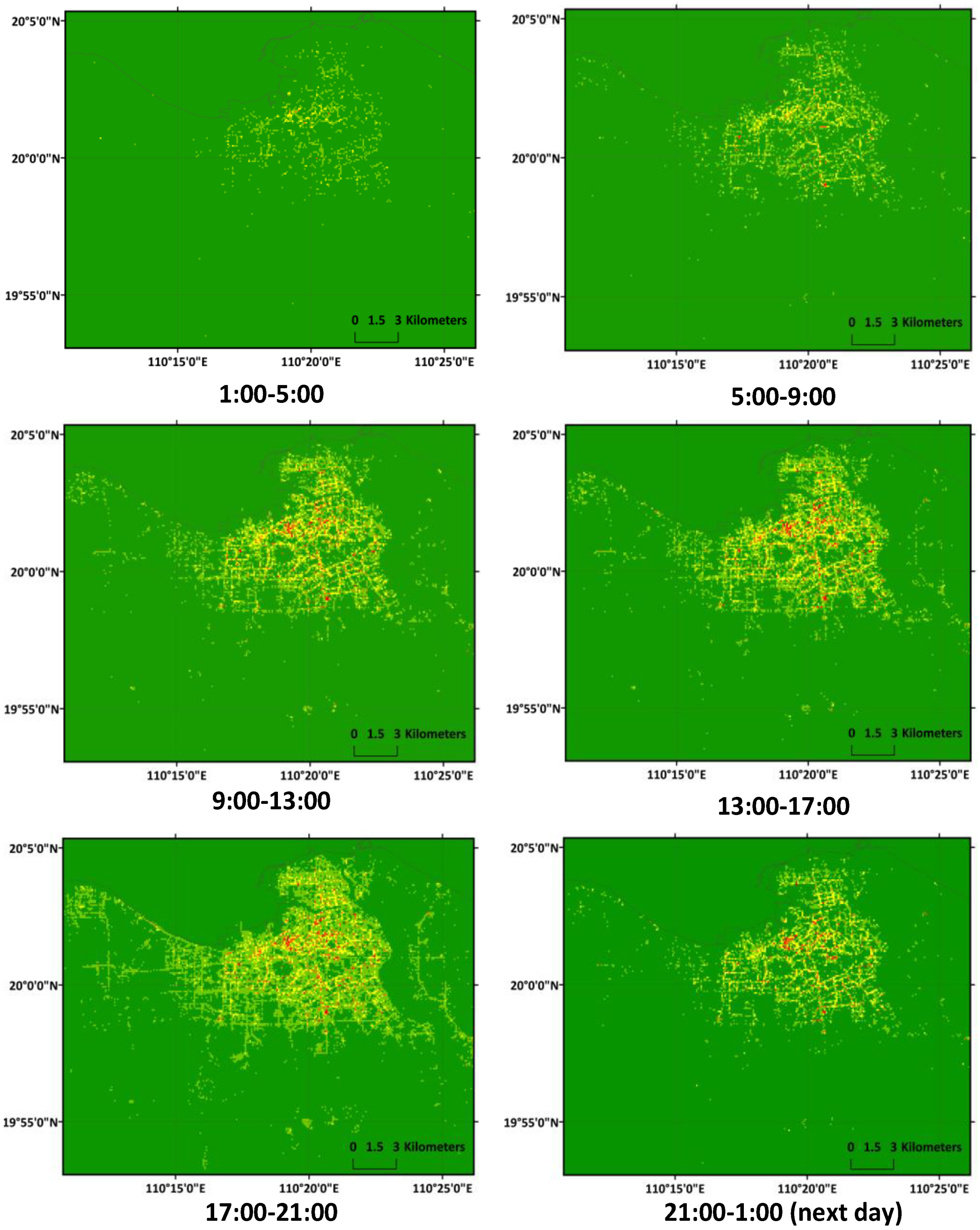


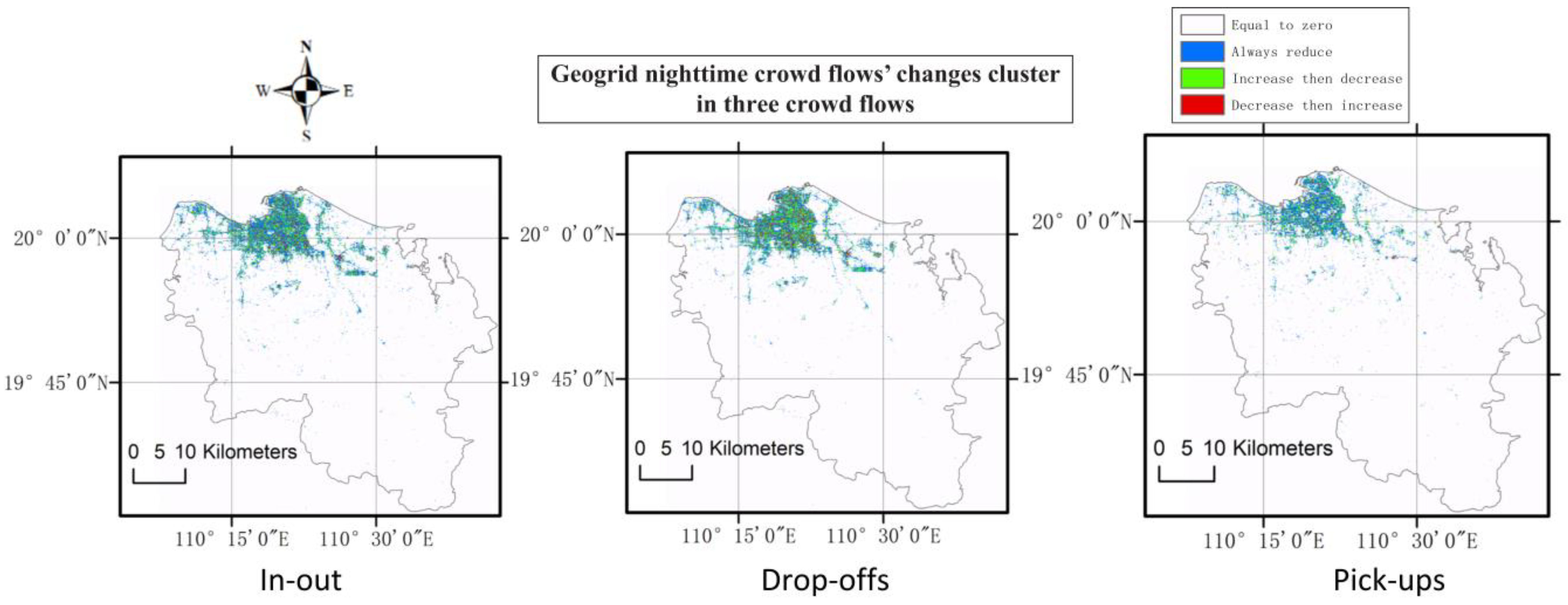
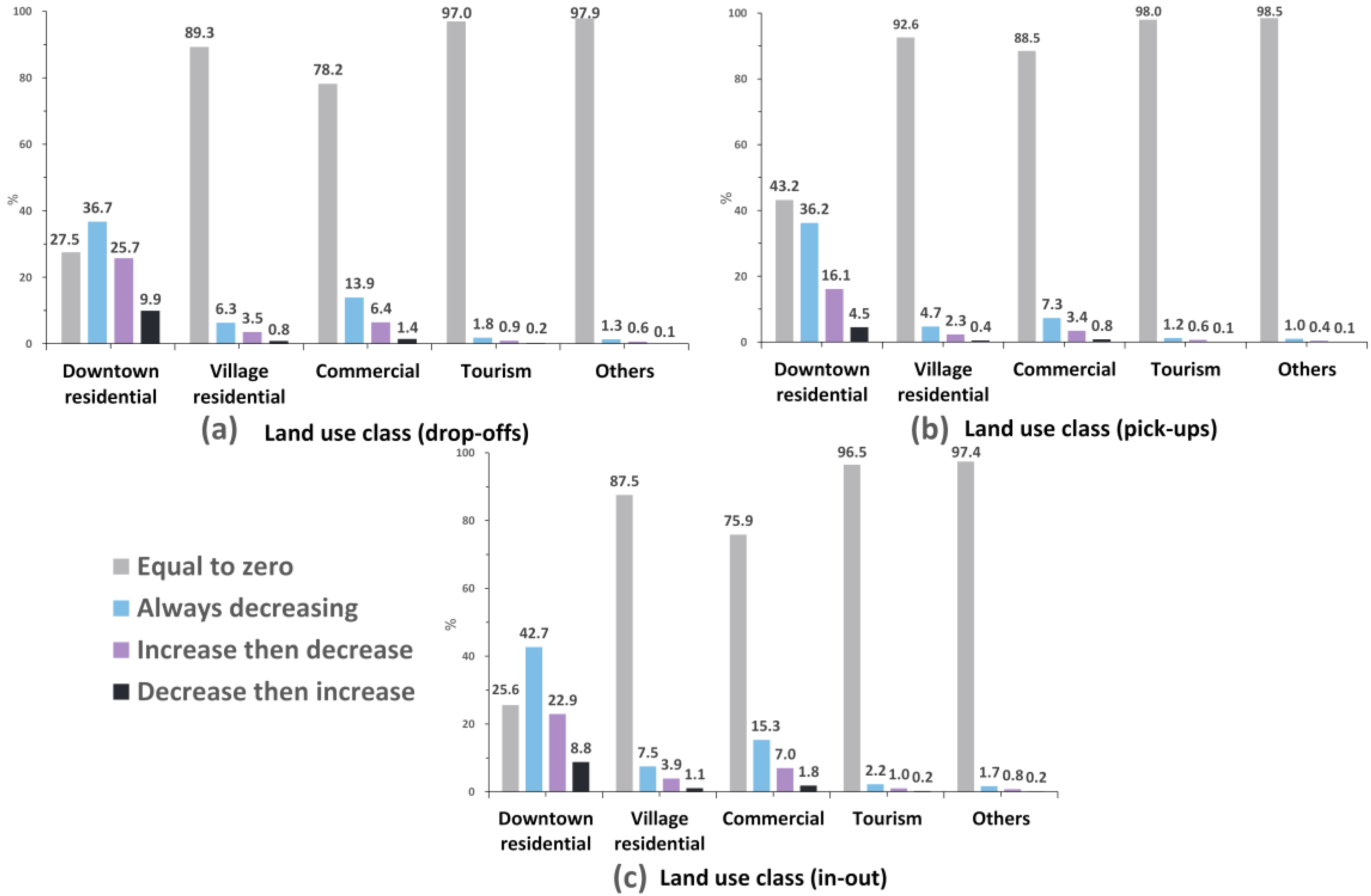
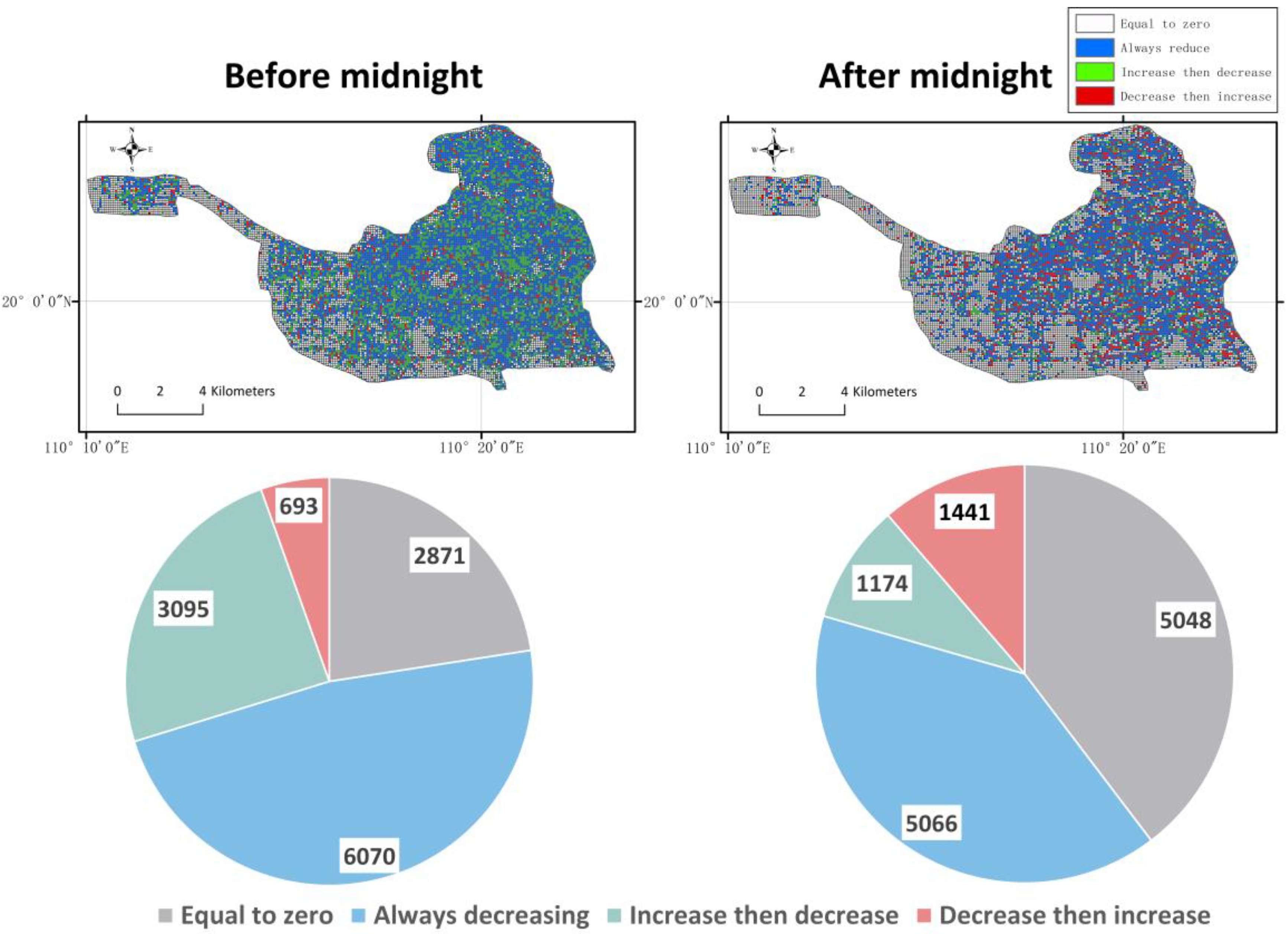
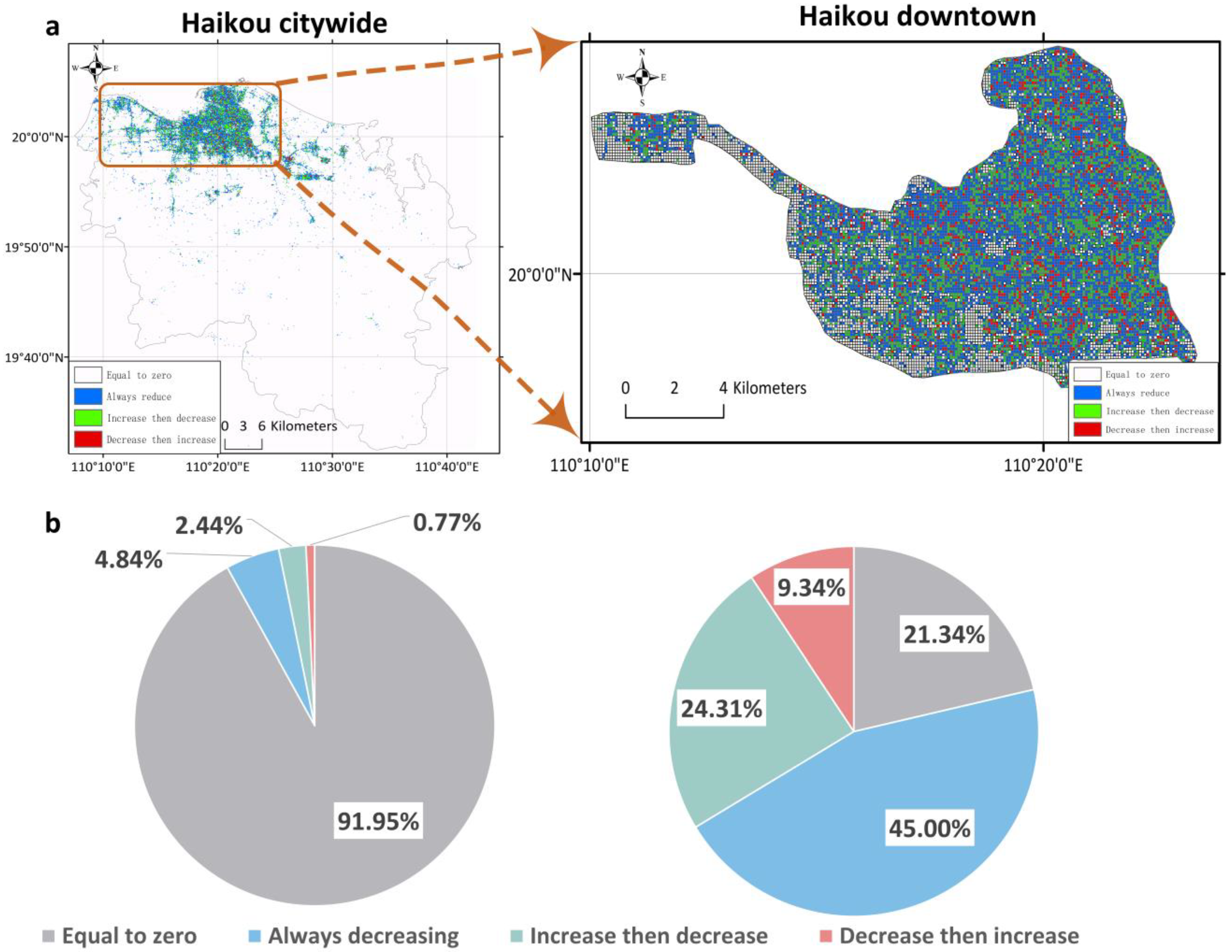
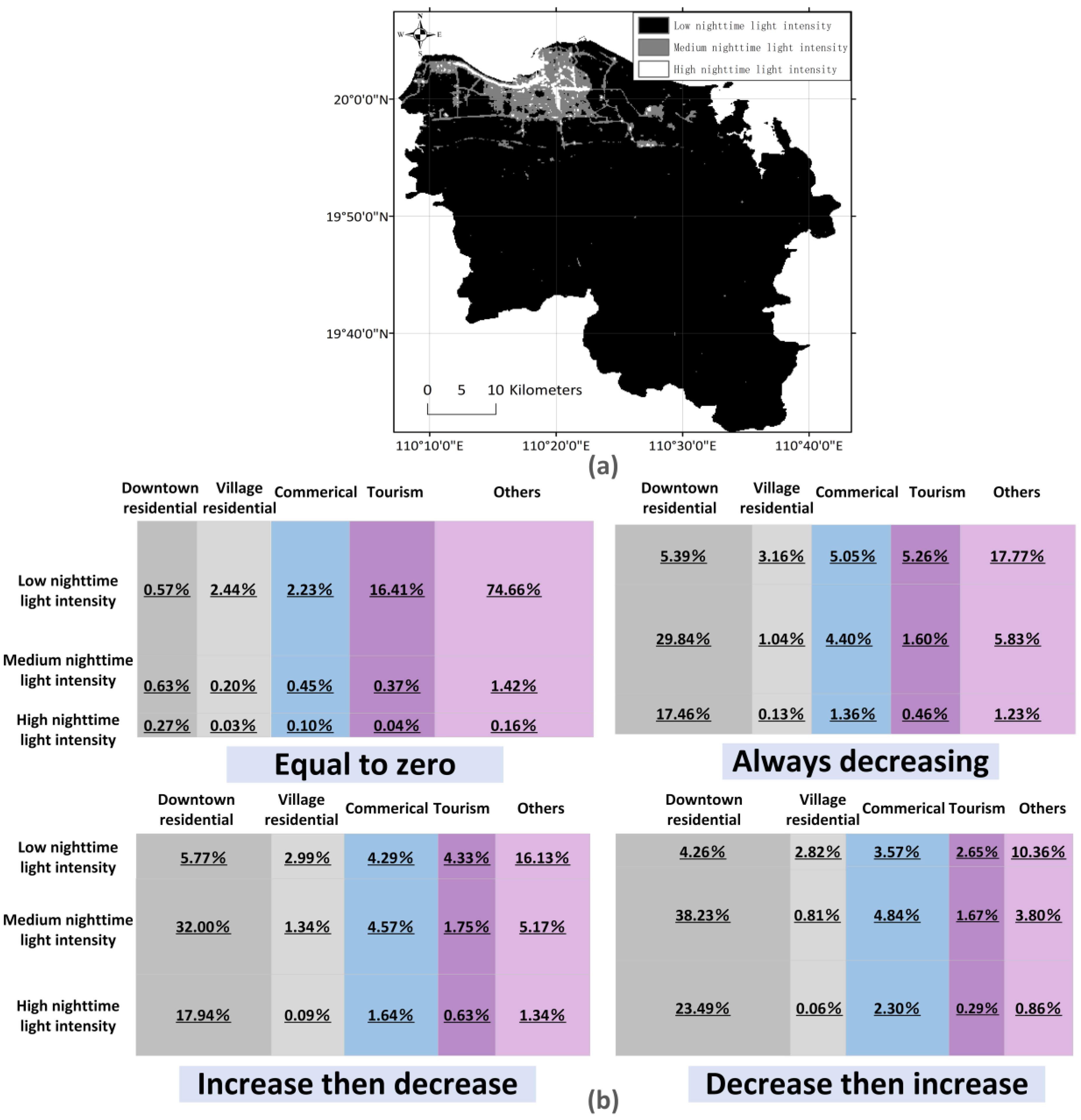
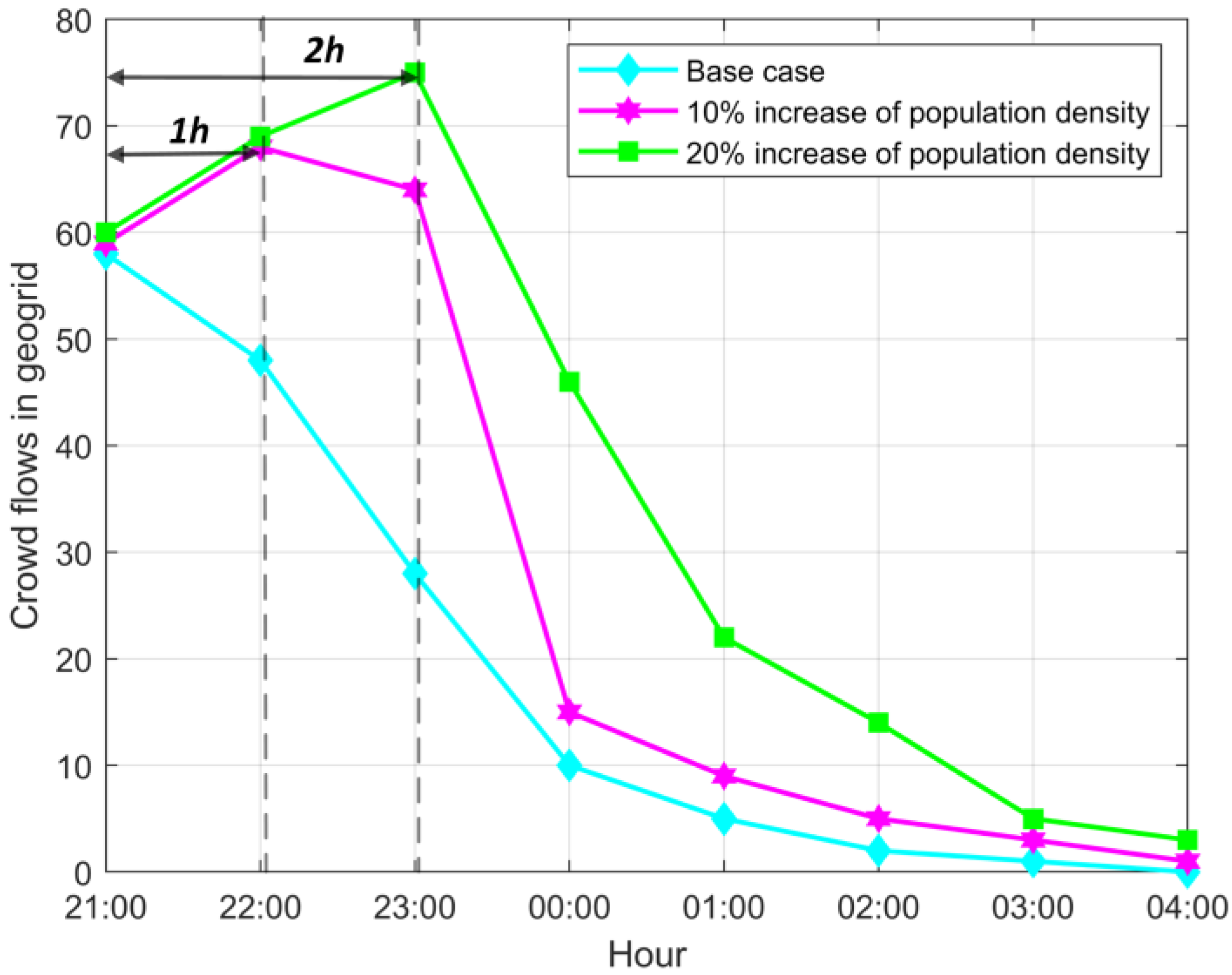
| Land Use | Subclass |
|---|---|
| Commercial | business area and land for factories and mines, large industrial areas, oil fields, salt fields, quarries, as well as traffic roads, marine ports, airports and special land |
| Tourism | forests, meadows, sea beaches, tourist-type rivers, POIs, hotel clusters, and other areas conducive to the growth of tourism |
| Downtown Residential | the land in large, medium, and small cities and built-up areas above the county town |
| Village Residential | rural settlements, arable land and ranch land that are independent of towns |
| Other Areas | Sandy land, Gobi, saline land, marshland, bare land, bare rocky land, shrubland, reservoirs, and other unpopulated areas that are not suitable for developing secondary and tertiary industries |
| Order 1 | Order 2 | Order 3 | Order 4 | … | |
|---|---|---|---|---|---|
| Order id | 175927190437 | 175928802315 | 175943512726 | 175958696894 | … |
| Departure time | 19 May 2018 1:05:19 | 26 May 2018 0:02:43 | 23 July 2018 23:55:20 | 20 Sep 2018 21:49:00 | … |
| Starting_lng, Starting_lat | 110.3665°, 20.0059° | 110.3249°, 20.0212° | 110.3446°, 19.9834° | 110.2913°, 20.0236° | … |
| Arrive time | 19 May 2018 01:09:12 | 26 May 2018 00:04:47 | 23 July 2018 23:59:02 | 20 Sep 2018 21:53:17 | … |
| Dest_lng, Dest_lat | 110.3645°, 20.0353° | 110.34629°, 20.0226° | 110.3598°, 20.0430° | 110.3740°, 20.0212° | … |
| Land Use Area | Low Nighttime Light Intensity | Medium Nighttime Light Intensity | High Nighttime Light Intensity | Nighttime Population Density |
|---|---|---|---|---|
| Downtown residential | 16.53% | 27.94% | 55.52% | High population density (70–100%) |
| Commercial | 68.21% | 21.04% | 10.75% | High population density (70–100%) |
| Village residential | 88.80% | 9.91% | 1.30% | Medium population density (60–70%) |
| Tourism | 96.54% | 2.97% | 0.48% | Low population density (0–60%) |
| Other | 97.22% | 2.43% | 0.35% | Low population density (0–60%) |
Publisher’s Note: MDPI stays neutral with regard to jurisdictional claims in published maps and institutional affiliations. |
© 2022 by the authors. Licensee MDPI, Basel, Switzerland. This article is an open access article distributed under the terms and conditions of the Creative Commons Attribution (CC BY) license (https://creativecommons.org/licenses/by/4.0/).
Share and Cite
Han, B.; Zhu, D.; Cheng, C.; Pan, J.; Zhai, W. Patterns of Nighttime Crowd Flows in Tourism Cities Based on Taxi Data—Take Haikou Prefecture as an Example. Remote Sens. 2022, 14, 1413. https://doi.org/10.3390/rs14061413
Han B, Zhu D, Cheng C, Pan J, Zhai W. Patterns of Nighttime Crowd Flows in Tourism Cities Based on Taxi Data—Take Haikou Prefecture as an Example. Remote Sensing. 2022; 14(6):1413. https://doi.org/10.3390/rs14061413
Chicago/Turabian StyleHan, Bing, Daoye Zhu, Chengqi Cheng, Jiawen Pan, and Weixin Zhai. 2022. "Patterns of Nighttime Crowd Flows in Tourism Cities Based on Taxi Data—Take Haikou Prefecture as an Example" Remote Sensing 14, no. 6: 1413. https://doi.org/10.3390/rs14061413
APA StyleHan, B., Zhu, D., Cheng, C., Pan, J., & Zhai, W. (2022). Patterns of Nighttime Crowd Flows in Tourism Cities Based on Taxi Data—Take Haikou Prefecture as an Example. Remote Sensing, 14(6), 1413. https://doi.org/10.3390/rs14061413







